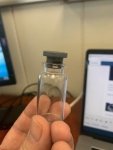I am working on a project miles above my ability, if you have any pointers on resources, here is a description of the animation:
1) A large silver coil begins to collect a millimeter thick cover of frost
2) The frost gets "blown" off the coil in a puff of air
3) The frost fog now is whisked down the center of the coil
4) We zoom in on the frost fog as it enters a steel chamber beyond the coil
5) Zooming so close we can now see individual sparkles of ice crystals that make up the frosty fog
6) As the fog expands, we see the crystals grow apart from each other
7) Now the crystals are far apart enough so that only one or two will fall into glass vials, roughly the size of bic lighter
8) We zoom in on one of the vials and see two tiny ice crystals fall into the vial, which is 1/8th full of water
9) When the two ice crystals hit the water, inside of the glass vial, they start off a nucleation reaction causing the water to turn into a slush of crystalized water
10) The water now about three seconds later solidifies into ice
11) The top of the vial has a rubber cork with vents on the side of it
12) The ice begins to vaporize and drift out of the vials through the rubber cork vents
13) Where the water used to be, there is now a cake of whitish powder remaining'
end of aninimation
1) A large silver coil begins to collect a millimeter thick cover of frost
2) The frost gets "blown" off the coil in a puff of air
3) The frost fog now is whisked down the center of the coil
4) We zoom in on the frost fog as it enters a steel chamber beyond the coil
5) Zooming so close we can now see individual sparkles of ice crystals that make up the frosty fog
6) As the fog expands, we see the crystals grow apart from each other
7) Now the crystals are far apart enough so that only one or two will fall into glass vials, roughly the size of bic lighter
8) We zoom in on one of the vials and see two tiny ice crystals fall into the vial, which is 1/8th full of water
9) When the two ice crystals hit the water, inside of the glass vial, they start off a nucleation reaction causing the water to turn into a slush of crystalized water
10) The water now about three seconds later solidifies into ice
11) The top of the vial has a rubber cork with vents on the side of it
12) The ice begins to vaporize and drift out of the vials through the rubber cork vents
13) Where the water used to be, there is now a cake of whitish powder remaining'
end of aninimation


